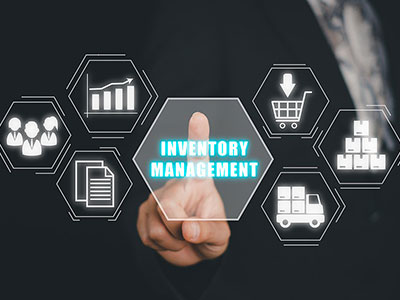
Why Is Inventory Accuracy Foundational to Success?
Inventory accuracy is foundational to success. Most clients aren’t concerned about inventory, and they shouldn’t be if they can count on what their system says. However, in every case, inventory must be maintained to ensure your foundation is strong and will support customer service, revenue growth, operational efficiency, and cash flow goals. It is also foundational for maintaining financial records and a foundational requirement for Sarbanes Oxley.
For example, a security products manufacturing client called with concerns about decreasing profits. They were concerned that they couldn’t predict their costs and therefore their profit, and they thought it related to their use of the system. After performing an assessment of their people, processes and systems, it was clear that putting costs in their system didn’t make sense until they had a solid foundation to build upon. Inventory accuracy was one of those foundational elements that had to get in place before advanced layers of process and system capabilities were added. Fast-forward four months, and their inventory accuracy was intact, base product data was available, and they had gained control of their business and were better able to predict performance – and could advance from there.
Essential Inventory Accuracy Basics
Inventory accuracy boils down to a few simple concepts including:
- Process disciplines: The 80/20 of inventory accuracy success requires process disciplines to be implemented throughout your company. The tricky part of this equation is explaining the importance, establishing the connection points between processes, marrying the processes with the systems, and ensuring priorities are in place to complete processes and system transactions on a timely basis, in the correct sequence, and with the appropriate controls in place. Process disciplines cover from receiving and production to transfers (intercompany and intracompany) and shipments. In essence, any transaction that impacts inventory must be included.
- Use of the system: If process disciplines are intact, the only other root cause we’ve seen over a combined 100 years of manufacturing and distribution experience is the use of the system. Not all scenarios are created equal. For example, in several situations, intracompany transfers were an issue from an inventory standpoint. In a consumer products manufacturer, their system didn’t allow for tracking intransit properly, and so their inventory “disappeared” while intransit. In a building and construction products manufacturer, their system was highly capable, but the long-term processes didn’t account for transfers properly. Again, the result was “invisible” inventory.
- Root cause analysis: It is common to have inventory inaccuracies. No client has 100% inventory accuracy over the course of a year as perfection is cost prohibitive. On the other hand, many clients can maintain reasonable inventory accuracy with process disciplines and cycle counting. This suffices whereas only the best (around 20-30%) have substantial root cause analysis built into the culture and routines. If reasonable “works”, why strive for the best? They have fewer high skilled resources tied up in maintaining the foundation. Instead, these key resources are focused on profitable growth and advancing the business.
With these three essential inventory accuracy basics, a strong foundation is intact.
Maintaining Inventory Accuracy with Cycle Counting
The key to maintaining inventory accuracy is cycle counting. In essence, it is counting a subsection of your inventory on a daily basis to confirm your inventory accuracy foundation remains intact. Although there are many strategy options, common sense rules the day. ABC cycle counting means you count the material items (in terms of value, volume and/or customer impact) more frequently (that usually account for 20% of your items that equal 80% of your value) while counting the least material items (that usually account for 80% of your items that equal 20% of your value) less frequently. Instead of counting and adjusting, counting and adjusting in a vicious cycle, you focus attention on root cause analysis and resolution. Doing this for the “A” items will positively “B” and “C” items as well since the same process disciplines are required.
How Does a Physical Inventory Fit into the Picture?
In most situations, once you implement a solid cycle counting process where you cycle through your full inventory at minimum on a yearly basis, you can provide evidence to Finance Auditors that your inventory will be “better” than performing a physical inventory. For example, if the people counting aren’t familiar with the units of measure and products, counting errors increase. Thus, many companies no longer require a full physical inventory. On the other hand, if inventory accuracy metrics start going off-track, it might be time to regroup with a physical inventory and a reimplementation of cycle counting.
The Bottom Line
You don’t want to be sitting happily and unwittingly in a house of cards. Thus, don’t have your house sit on a faulty foundation. Prioritize the appropriate resources to set up solid inventory accuracy processes and tracking mechanisms. If you aren’t in front of inventory variances and root causes, consider bringing on a supply chain consultant. You won’t need significant expertise long term for inventory accuracy alone, and so a short-term expert might fit that bill. Once intact, provide training and education, and make sure a regular review of metrics with Executives is a part of the process. It can be incorporated into the metrics slides of a SIOP (Sales Inventory Operations Planning), also known as S&OP, process to get a regular cadence with Executives.
Please contact us with your stories, issues, and ideas on inventory accuracy and cycle counting. And please keep us in the loop of your situation and how we can help your organization upgrade your inventory accuracy processes to support profitable growth in addition to satisfying compliance objectives.
P.S. To get ahead of the curve on where to focus for the best results to build on your foundation to get ahead of the competition, download our latest complimentary special report.


